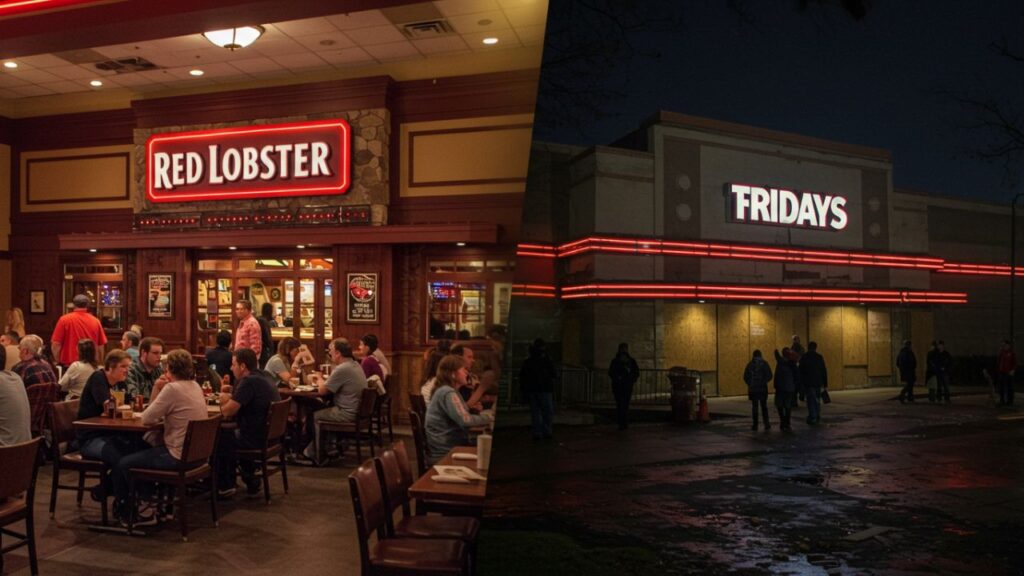The phrase Red Lobster TGI Fridays closing has been echoing across newsfeeds, sparking concern among diners who have long associated these names with casual dining comfort. For many, the thought of losing a go-to seafood feast or a Friday night burger is unsettling. However, the reality is more complex—and far less grim—than the headlines might suggest.
This isn’t simply about beloved restaurants disappearing overnight. Instead, it’s a story of market adaptation, financial restructuring, and an attempt to reinvent in the face of industry headwinds. Both Red Lobster and TGI Fridays are making tough calls—closing underperforming locations—to emerge leaner, stronger, and better positioned for the future.
Understanding Red Lobster’s Restructuring Journey
Red Lobster has been a staple in American dining since 1968, known for its cheddar bay biscuits and affordable seafood platters. But in May 2024, the chain filed for Chapter 11 bankruptcy. This wasn’t a sudden collapse; rather, it was the culmination of rising costs, operational inefficiencies, and changing consumer habits.
The bankruptcy filing led to the closure of 99 underperforming U.S. locations, many of which had been struggling for years. Cities like Buffalo, Orlando, and various mid-sized markets saw long-standing restaurants shutter with little warning. Equipment and furniture were quickly auctioned off, signaling the urgency of the restructuring plan.
By late 2024, Red Lobster had successfully exited bankruptcy under new ownership from RL Investor Holdings. Roughly 550 locations remain open across the U.S., and the brand is actively working on operational streamlining, menu innovation, and marketing strategies to win back customers.
TGI Fridays’ Shift Toward a Leaner Model
If Red Lobster’s troubles came as a surprise, TGI Fridays’ restructuring was perhaps even more sobering. Once a pioneer in the casual dining sector, the chain has faced declining traffic for over a decade.
In November 2024, TGI Fridays also filed for Chapter 11 bankruptcy. The move resulted in a steep drop from about 270 corporate-owned U.S. restaurants to just 85 by early 2025.
However, not all closures meant complete exits. Many shuttered corporate locations were sold to franchise operators, which allowed the brand to shift toward a less risky business model. While the U.S. footprint shrank dramatically, international locations—over 600 worldwide—continue to operate without major disruption.
Why Are These Closures Happening Now?
The near-simultaneous restructuring of both brands reflects broader changes in the casual dining sector:
-
Rising Inflation and Costs – Food prices, labor wages, and utility bills have increased significantly, squeezing profit margins.
-
Shifting Consumer Preferences – More diners are choosing fast-casual and delivery options over full-service dining.
-
Legacy Debt and Long-Term Leases – Older chains often have expensive real estate commitments and debt from past expansions.
-
Competition from Smaller, Trendier Brands – Independent restaurants and niche chains have gained traction with younger customers seeking novelty.
These factors have created a “perfect storm” that forces older chains to rethink how they operate.
Strategic Closures vs. Total Collapse
It’s important to understand that “closing” doesn’t always mean “vanishing.” In both cases, the closures are part of a strategic realignment:
-
Red Lobster: Focusing on fewer, more profitable locations; updating menu items with fresher seafood sourcing; enhancing delivery and takeout capabilities.
-
TGI Fridays: Streamlining U.S. operations, expanding franchise partnerships, and introducing menu items aimed at a younger, more globally diverse audience.
By closing underperforming locations, both brands aim to cut losses and redirect resources toward areas with higher growth potential.
Impact on Communities and Employees
Closures inevitably affect local economies. Many communities have lost not only a restaurant but also a significant employer. While some employees have been transferred to nearby locations, others have faced layoffs.
To mitigate the impact, TGI Fridays has encouraged franchise buyers to retain staff wherever possible, and Red Lobster has offered severance packages in some markets. Still, the closures mark the end of long-standing community gathering spots in many towns.
How the Dining Landscape Is Changing
These developments are not isolated. In recent years, numerous large restaurant brands have scaled back, including Ruby Tuesday, Applebee’s, and Outback Steakhouse.
The new normal for casual dining appears to be smaller footprints, more digital ordering, and a stronger focus on takeout and delivery. Consumers now expect convenience alongside quality—something older chains are still working to integrate into their operations.
Looking Ahead: Will Red Lobster and TGI Fridays Survive?
Industry analysts are cautiously optimistic. Both brands still have strong name recognition, loyal customer bases, and international presence.
For Red Lobster, the key lies in reinvigorating the menu and positioning itself as the go-to affordable seafood option. For TGI Fridays, brand refreshes, updated interiors, and global expansion may offer the best route to renewed relevance.
Lessons From These Closures
-
Adaptability Is Critical – Consumer dining habits change quickly, and brands must respond before decline becomes irreversible.
-
Size Isn’t Always an Advantage – A massive footprint can become a liability if too many locations underperform.
-
Global Diversification Helps – TGI Fridays’ strong international base has cushioned its U.S. losses.
-
Bankruptcy Isn’t Always the End – For both chains, Chapter 11 has been a lifeline rather than a death sentence.
What This Means for Diners
For loyal customers, the main takeaway is that your favorite chain isn’t gone—just leaner. Many prime locations are still open, and some closures might even lead to improved service and food quality as operations become more focused.
If anything, this could be the start of a new chapter where these brands modernize and reconnect with the evolving tastes of American diners.
Final Thought
The Red Lobster TGI Fridays closing headlines paint a picture of loss, but beneath the surface is a story of adaptation. This is less about chains disappearing and more about survival in a challenging dining landscape.
For now, fans can still enjoy cheddar bay biscuits or a loaded TGI burger—just perhaps not at the exact corner they’ve been visiting for years. The locations may change, but the brands are still fighting for a seat at America’s dining table.





